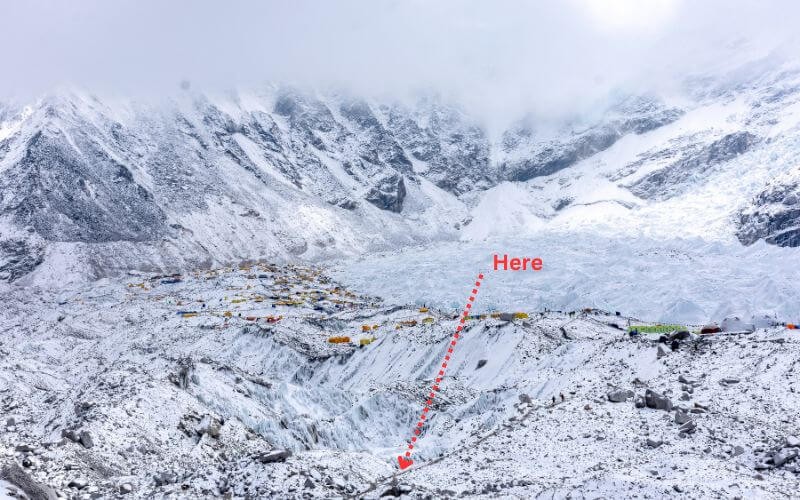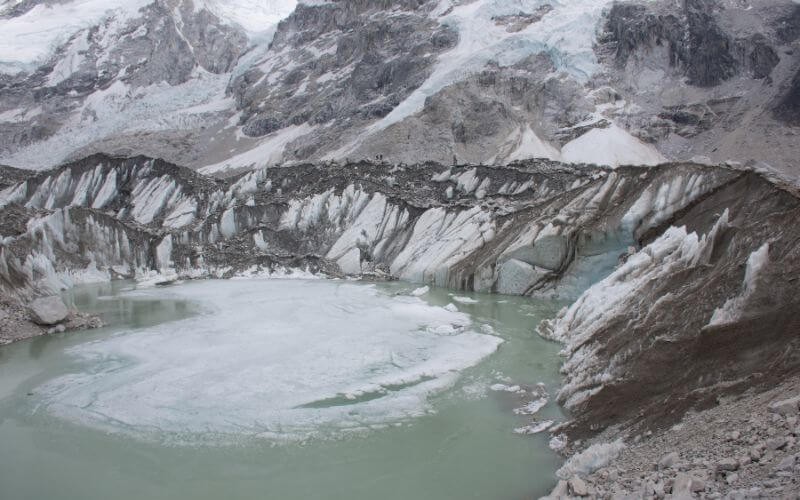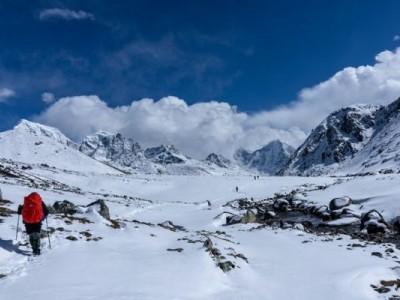Table of Contents
The pristine beauty and majestic allure of the Himalayan mountain range have captivated hearts for centuries. However, behind this breathtaking facade lies a growing environmental crisis: the rapid melting of glaciers.
Here is the undeniable evidence captured through two pictures taken at Base Camp, just one month apart. These images serve as poignant reminders of the dire consequences of climate change and the urgent need for global action.
Picture 1 (Taken in April 2023):

The first picture captures the moment at Everest Base Camp adorned with glistening glaciers. Yet, beneath this serene surface, a profound transformation is unfolding, and the second picture serves as an undeniable testament to this alarming reality.
Picture 2 (Taken recently on May 2023):

In stark contrast to the previous image, the second picture paints a drastically altered landscape. The once-pristine glacier has undergone rapid and unsettling changes within a mere month. The visible meltwater has formed in this rocky terrain. The retreat of the glacier is evident, leaving behind deep crevasses and exposed rock faces, serving as solemn reminders of the irreversible damage caused by global warming.
The Impact of Climate Change:
The acceleration of glacier melting in the Himalayas directly results from climate change. Rising global temperatures have caused interconnected events that intensify the melt rate.
As greenhouse gases trap heat in the atmosphere, the resulting temperature increase affects the Himalayan region more significantly than other parts of the world.
The Himalayan glaciers act as crucial water sources, feeding the rivers and sustaining the livelihoods of millions of people downstream. The accelerated melting poses a severe threat to the delicate ecological balance and the communities that depend on these vital water sources. With the glacial meltwater reduced, downstream areas may face water scarcity, affecting agriculture, hydropower generation, and freshwater availability.
The Role of Human Activities:
While natural climate variability plays a part in glacial melting, human activities at the Everest Base Camp also have significantly exacerbated the problem. The burning of fossil fuels releases greenhouse gases into the atmosphere, contributing to the warming effect.
Additionally, uncontrolled tourism and improper waste management in the Khumbu region further contribute to the degradation of this fragile ecosystem.
The Urgency of Global Action:
The alarming rate of glacier melt in the Himalayas underscores the urgency of global action to mitigate climate change. International cooperation is crucial for reducing greenhouse gas emissions, transitioning to sustainable energy sources, and implementing effective policies to protect vulnerable ecosystems.
Governments, environmental organizations, and individuals must work collectively to raise awareness, promote sustainable practices, and support research initiatives focused on understanding and mitigating the impact of climate change on the Himalayan glaciers.
Government and Local Level authorities:
- Nepal Mountaineering Association (NMA)
- Nepal Tourism Board (NTB)
- Sagarmatha National Park
- Khumbu Village Development Committe
The rapid melting of glaciers in the Himalayas demands immediate attention and action. The two pictures taken at Everest Base Camp, just one month apart, provide a compelling visual representation of the urgency and scale of the problem.
Himalayan Ecological Trek has been operating in the trekking, climbing, and tour sectors since 1995. Throughout the years, we have witnessed significant changes in Nepal's tourist attractions, with one particularly notable transformation being the rapid melting of glaciers in the Himalayas. The once snow-capped mountains that adorned the trekking trails have now been reduced to barren hills.
With our extensive presence in the trekking and travel industry for over two decades, we have recognized the pressing need for people to embrace a sustainable mindset toward the environment. It has become increasingly clear that if we wish to leave a better Earth for future generations, everyone must contribute towards the well-being of our planet actively. Developing a sustainable tourism industry is imperative in this regard.
By addressing the root causes of climate change and taking concrete steps toward sustainability, we can strive to preserve the pristine beauty and ecological integrity of the Himalayas for generations to come.


